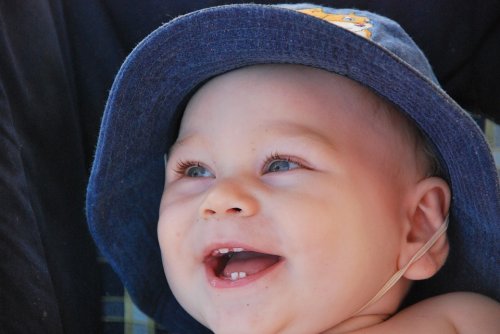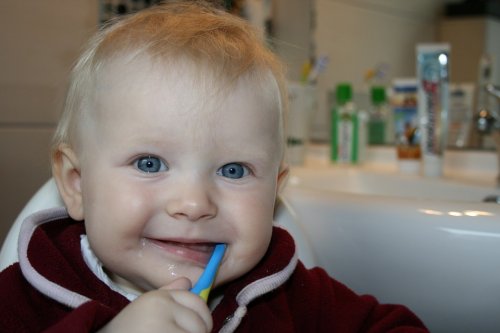My Baby's First Tooth


Reviewed and approved by the doctor Nelton Ramos
Has your baby spent several days drooling and transferring everything he carries in his fist to his mouth? Has he been crying for no reason? You might be able to feel that he is in some sort of pain, and this is due to his first tooth.
Check the gums to see if they are red and swollen or have some symptoms of breakage. It’s possible that soon everything will come to pass and the tip of his first tooth will appear.
Around seven months of age, more or less, your child will have a tooth. Generally it erupts in the lower frontal area of the mouth. And it is at that precise moment, when the entire family applauds the appearance of that pearly white, that your baby will feel at home.
Of course, as you first go through those uncomfortable days, you need to take action to ease the eruption of that first tooth. And that should be combined with the recommendations of a pediatric dentist.

When should you plan for those uncomfortable days? Ideally from birth. If you’re wondering why you should start so early, we must explain that your little one already has all of his milk teeth inside his gums during the ninth month of gestation. These teeth are like little seeds inside his mouth and have surprised some with their early appearance.
Let’s get ready
Now, while some babies pass their teeth without knowing it, others feel a lot of discomfort. In the latter case, what should we do to make sure our baby suffers as little as possible from the first eruption? We are talking about simple measures:
- Everyone has their own pace, so don’t worry if a tooth comes within four months, seven months or one year. With this in mind, give him daily gentle massages on the gums with gauze dipped in boiled water that has been cooled to room temperature.
- Rub the gum with ice or a few drops of the painkiller you use to lower your fever if it creates pain. There are also analgesic, even homeopathic ointments. Have one in the baby’s kit. That first tooth can come when you least expect it.
- Have a teething ring at home for your baby to bite. He will do it with the right intensity.
- If he is in a lot of pain, take your baby to the pediatric dentist. Gums hurt but not to the extreme.
- If your baby has diarrhea and a high fever, it’s not because of teething. Your pediatrician will know what to do.
- Cool a teaspoon in the fridge. If you put it on the inflamed gum, pressing gently, it will help the tooth cut the gum.
- If you don’t have a teething ring, a peeled and cold carrot is very good for biting. Be careful to cut off the tip, lest it goes up his nose.
Dental Care
According to the Spanish Association of Pediatrics, it is a myth that the pacifier deforms the gums or damages the baby’s teeth. Furthermore, it can be used for up to three years because it calms crying, helps sleep and reduces stress. Recent studies relate their use, particularly during sleep, with reduced risk of sudden infant death syndrome.
In addition, breastfeeding is very important. It is proven that children who nurse will have fewer malocclusion problems (a bad bite). Breast suction will ensure correct growth of all your baby’s teeth and development of his mouth.

The fact that he still doesn’t have teeth doesn’t mean that your baby’s mouth is not exposed to bacterial decay. That is why it is advisable to clean his gums with a damp cloth every day. Once the first tooth surfaces, you should clean it with a damp gauze, then offer water to remove all residue. If he falls asleep while taking the bottle, clean it when he wakes up; milk residue contains bacteria.
After the first tooth (lower central incisor) erupts, its partner will soon appear. The maxillary central incisors will then erupt, followed by the lateral incisors, the canines and finally the molars about 30 months later (some will get it in more or less time) when they have a full set of 20 teeth.
Keep in mind that the care of milk teeth influences the health of the permanent teeth. That is why after a year, when your child has 8 teeth, you should start using a toothbrush and teaching your child to rinse with water. And as they love to imitate Mom… you’ll see that your baby will have a lot of fun spitting out the water!
Has your baby spent several days drooling and transferring everything he carries in his fist to his mouth? Has he been crying for no reason? You might be able to feel that he is in some sort of pain, and this is due to his first tooth.
Check the gums to see if they are red and swollen or have some symptoms of breakage. It’s possible that soon everything will come to pass and the tip of his first tooth will appear.
Around seven months of age, more or less, your child will have a tooth. Generally it erupts in the lower frontal area of the mouth. And it is at that precise moment, when the entire family applauds the appearance of that pearly white, that your baby will feel at home.
Of course, as you first go through those uncomfortable days, you need to take action to ease the eruption of that first tooth. And that should be combined with the recommendations of a pediatric dentist.

When should you plan for those uncomfortable days? Ideally from birth. If you’re wondering why you should start so early, we must explain that your little one already has all of his milk teeth inside his gums during the ninth month of gestation. These teeth are like little seeds inside his mouth and have surprised some with their early appearance.
Let’s get ready
Now, while some babies pass their teeth without knowing it, others feel a lot of discomfort. In the latter case, what should we do to make sure our baby suffers as little as possible from the first eruption? We are talking about simple measures:
- Everyone has their own pace, so don’t worry if a tooth comes within four months, seven months or one year. With this in mind, give him daily gentle massages on the gums with gauze dipped in boiled water that has been cooled to room temperature.
- Rub the gum with ice or a few drops of the painkiller you use to lower your fever if it creates pain. There are also analgesic, even homeopathic ointments. Have one in the baby’s kit. That first tooth can come when you least expect it.
- Have a teething ring at home for your baby to bite. He will do it with the right intensity.
- If he is in a lot of pain, take your baby to the pediatric dentist. Gums hurt but not to the extreme.
- If your baby has diarrhea and a high fever, it’s not because of teething. Your pediatrician will know what to do.
- Cool a teaspoon in the fridge. If you put it on the inflamed gum, pressing gently, it will help the tooth cut the gum.
- If you don’t have a teething ring, a peeled and cold carrot is very good for biting. Be careful to cut off the tip, lest it goes up his nose.
Dental Care
According to the Spanish Association of Pediatrics, it is a myth that the pacifier deforms the gums or damages the baby’s teeth. Furthermore, it can be used for up to three years because it calms crying, helps sleep and reduces stress. Recent studies relate their use, particularly during sleep, with reduced risk of sudden infant death syndrome.
In addition, breastfeeding is very important. It is proven that children who nurse will have fewer malocclusion problems (a bad bite). Breast suction will ensure correct growth of all your baby’s teeth and development of his mouth.

The fact that he still doesn’t have teeth doesn’t mean that your baby’s mouth is not exposed to bacterial decay. That is why it is advisable to clean his gums with a damp cloth every day. Once the first tooth surfaces, you should clean it with a damp gauze, then offer water to remove all residue. If he falls asleep while taking the bottle, clean it when he wakes up; milk residue contains bacteria.
After the first tooth (lower central incisor) erupts, its partner will soon appear. The maxillary central incisors will then erupt, followed by the lateral incisors, the canines and finally the molars about 30 months later (some will get it in more or less time) when they have a full set of 20 teeth.
Keep in mind that the care of milk teeth influences the health of the permanent teeth. That is why after a year, when your child has 8 teeth, you should start using a toothbrush and teaching your child to rinse with water. And as they love to imitate Mom… you’ll see that your baby will have a lot of fun spitting out the water!
All cited sources were thoroughly reviewed by our team to ensure their quality, reliability, currency, and validity. The bibliography of this article was considered reliable and of academic or scientific accuracy.
- Kobayashi, Gomide, Carrara. Timing and sequence of primary tooth eruption in children with cleft lip and palate. J Appl Oral Sci. 2010; 18 (3): 220-4.
- Rahman, A. Dentición. Hojas de hechos familiares. American Academy of Pediatric Dentristy. [En línea] Disponible en: https://cchp.ucsf.edu/sites/g/files/tkssra181/f/TeethingSP013106.pdf
This text is provided for informational purposes only and does not replace consultation with a professional. If in doubt, consult your specialist.








